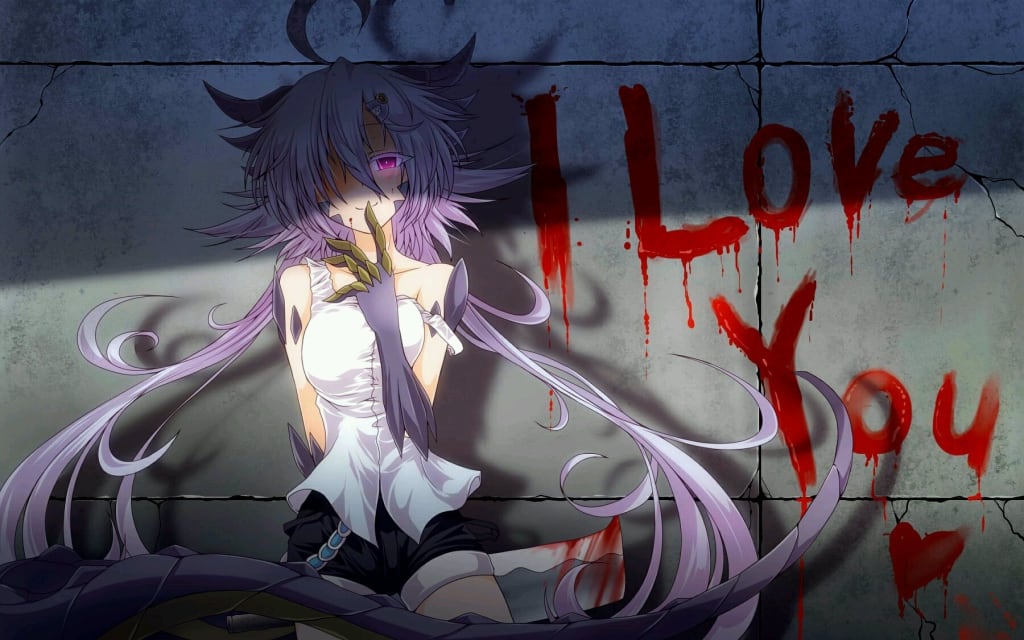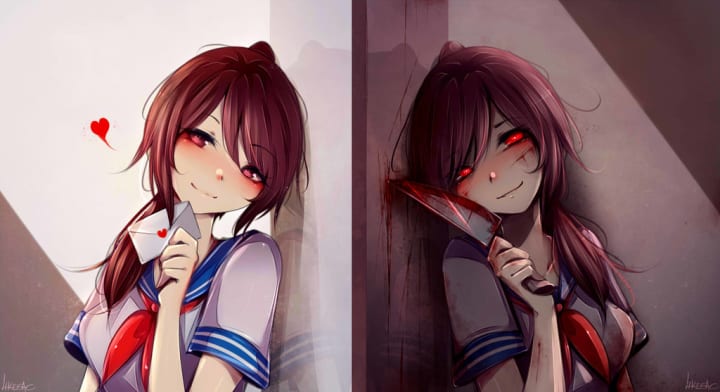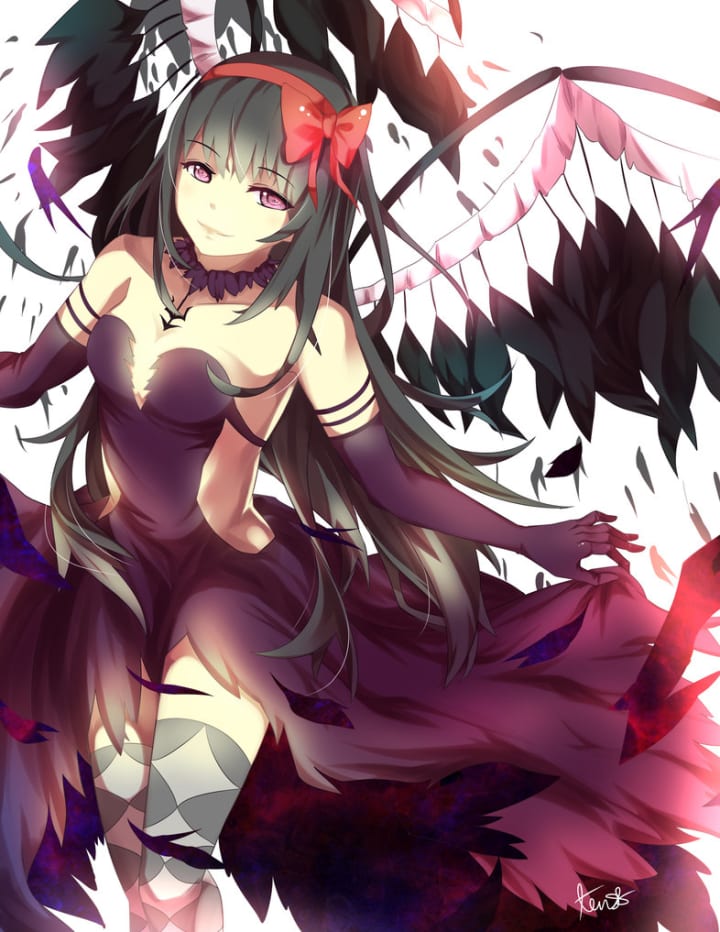
She’s beauty, she’s grace, she’ll rip off your face, then wear it as a token of her love for you. That’s cute, but you’re going to have to do more than that to create an engaging yandere for your story. Yanderes can’t be deemed as just crazy. They are the type of characters with fragmented minds and a skewed perception of reality. It’s up to you, the author, to reveal the truth of their psyche in a way that isn’t just terrifying. Your yandere must also be intriguing, relatable at times, and be someone your audience won’t underestimate. Never limit your yandere to being a plot device. The contemporary audience isn’t as sensitive to blood and violence as they used to be, so if your character unravels too quickly, you might lose the momentum of your story. We’ll breakdown how the psyche of a yandere twists and turns, then I’ll propose some “What if…” suggestions to prompt you to make sure your yandere stands out of the many adorable serial killers we have already.
1. Backstory – Why Do They Kill for Love?

Yandere Chan by Likesac on DeviantArt
The yandere’s backstory can range from traumatic to peaceful. It’s not really about who hurt them, but what incident conquered their mentality and convinced them to go to the extreme for love. Yanderes need an incident in their lives that triggers a pleasurable obsession and radical loyalty. Something in the yandere’s past threatened what they loved and awakened the full extent of their hostility. To put this in the terms of obsessive compulsive disorder (OCD), the obsession is the fear of losing what they love and the compulsion is protecting that love at all costs. A yandere’s world is blind devotion. Make sure their backstory emphasizes why fulfilling their obsession is worth more than their own life.
2. Your Yandere’s Modus Operandi

Homura Akemi by
Once you’ve established what or who your yandere loves, they should have a signature attack. Of course, this could be anything the author sees fit, and if you want to attach special meaning to the weapon, especially if it’s connected to your yandere’s backstory, go for it. The attack style can also contribute to your character’s personality. Yanderes can be sloppy brawlers, precise assassins, or sadistically clever. Correlate their mental instability and their disregard for other lives with their obsession AND their personality. Your yandere’s MO is meant to complement their sick mind. Do they like to hack-and-slash, use blunt force, or are they silent killers? If they use a variety of tactics, what causes them to switch it around?
3. What Makes Them Tick and What Do They Do About It? (Internal Conflict)

You know who this is...
Your yandere should show moments of irritation, jealousy, or frustration when the wrong button is pushed to show how devoted a yandere is to their obsession. They may hide it when around some characters and vent their frustrations elsewhere. However, the reaction will be aggressive. What stimulates that aggression is what your audience is interested in. When you create other characters who interact with your yandere, don’t miss those opportunities to make them snap. A yandere’s mind is unstable and the presence of factors beyond their control aggravates them. To enhance their instability, make sure to pinpoint how something that is no sweat to one character is a huge deal for your yandere.
4. Emphasizing the Obsession Without Being Cliché (External Conflict)

There are a lot of different nervous ticks or bad habits a person can develop when something bothers them. They’re worth exploring while creating your character so you don’t end up showing your audience what they’ve already seen. There are a variety of phobias and disorders you can explore to make your character more significant. For example, if you create a yandere who has a germ phobia, also known as mysophobia, they would most likely kill in a subtle way, like poisoning the food or drink of a threat rather than hacking them to bits. The habits of your character are meant to enhance their obsession and encourage your audience to really pay attention to the details of who they are. Show your audience how your character perceives the world around them.
5. Innocence Incognito

Like most serial killers, the yanderes are masters of blending in. The yandere wants to appear attractive to their target. Receiving mutual feelings from the target would put the yandere in paradise. Some yanderes may be reasonable enough to know that developing a rapport with their target takes time, but there are others who can get impatient and refuse rejection no matter what. Unrequited love usually causes the “yan” to develop, so you’ll have to make sure the character’s lovey-dovey side, or “dere,” is convincing enough to lure in other characters and the audience. The yandere’s innocent cover does more than just hide their true nature; it’s bait.
6. Yandere - Target Relationship
The target, the yandere’s love interest, can fall into three categories:

- When the Target HATES the yandere: A target who does not like the yandere initially will either be repulsed by the yandere’s true nature or like the yandere later. This target will probably be someone who thinks on their feet and does anything they can to get away from or survive the yandere. The yandere may adapt to the rejection by killing those the target loves or kill the target with the “If I can’t have you, nobody can” mind set.
- When the Target is NEUTRAL about the yandere: A target that sees the yandere as an acquaintance may be oblivious to the yandere’s feelings, then either disgusted or attracted to the yandere’s true nature later. Rarely does the target remain neutral, but it’s possible. These types of targets are usually vulnerable to fear and adopt the “fight, flight, or freeze” thought process. As the ultimate opportunist, the yandere will take advantage of the way the target thinks and plot to isolate them as their sole possession methodically.
- When the Target LIKES the yandere: A target that already fancies the yandere will like them initially and then be terrified or lovestruck when the yandere’s true nature is revealed. These targets are often destined for tragedy if they care for the yandere. The yandere may keep their target in the dark until they’re ready to announce their true love. God help the target if they deny the yandere’s love confession.
Targets vary in personality and the yandere’s responses to the target’s actions must reflect their perception of the relationship as a sick concoction of genuine and toxic. No matter what kind of target your yandere is after, they will put up a fight.
Yanderes - The Ultimate Die Hards

Yandere Gif by CandyKidEvie
Surely you’ve watched enough anime to know that yanderes have a hard time dying. Their obsession makes them resilient. It’s very rare for a yandere to allow themselves to be killed or kill themselves. A yandere’s death has often been used as the climax of the story or a distinct part of resolution, but again, I want to encourage you not to have the yandere be used as a plot device too often. It has happened WAY too many times. The timing of their death is more impactful when it’s unpredictable. Make sure their demise is shocking, and, perhaps, heartbreaking.
I hope that gave you something to think about when you start sculpting your hostile lover. Now let’s make sure we avoid the clichés.
What If...

- Gender Swap/Manipulation: There are far too many yanderes that are girls. I KNOW, they’re so cute! Why would we change that? Girls do often appear to be the more emotional type, but that isn’t always the case. Men and the genders in between have emotions too and they can be just as vulnerable to obsessive behaviors and possessive acts of passion.
- What if the target is more twisted than the yandere? Light Yagami from Death Note is someone I’ve seen that was more twisted than their twisted love interest, Misa Amane. Manipulative to the core, Light saw many innocent bystanders as tools for his ultimate goal and Misa complied with it fairly quickly as long as she got to be with him. Misa also threatened to kill anyone he dates. Once he died, Misa killed herself. Imagine the target being more sinister than the yandere and the yandere blindly obeying their every command. What would happen in the moment they don’t see eye to eye?
- What if the yandere was the villain no one suspected? Many stories bring in the “yan” part of a character too early to keep the audience captivated, but it sure would be interesting if there was a yandere that was clever and convincing enough to remain innocent until their “switch” happened when it’s least expected. Consider it a challenge to keep your audience involved until you drop the bomb. You may think this was done before, but I saw a show where I didn't know who the villain was until after SIX seasons. SIX.
- Experiment with genres and themes: We’ve seen the “innocent schoolgirl kills classmates” theme dozens of times. Don’t be afraid to place your yandere in a genre they have never been in before. If you want to stick with the school theme, it's better to have one hell of a plot twist because that’s as cliché as it gets, folks.
Archetypes

- Anti-Hero: Does not embody the normal traits of a hero such as moralism, idealism, and even courage, and in fact does the heroic thing mainly for self-satisfaction or some ego-centric need.
- Beast: A monster, but more human than the more literal monster archetypes. The beast could be someone like Hitler, a serial killer, or even a part of ourselves we are terrified of because of its capability for violence.
- Betrayer: Often found in both romance and politics, the betrayer is one who takes trust and destroys it.
- Destroyer/Killer: …Someone who destroys things, whether it be other people, objects, or situations. This is a destructive soul, but not necessarily evil.
- Devil: …the shadow self and the dark side combined… can be the expression of evil, violence, and destruction in an otherwise good heart… can also be our inner repressed sexual urges and desires.
- Dictator: Arrogant ruler, control freak… must have things done his/her way.
- Doppelganger: … identifies the duplicate or shadow/evil part of a personality (Dr. Jeckyll and Mr. Hyde).
- Femme Fatale/Tempter: sexual and seductive… a woman who knows what she wants and how to get it, to a dangerously seductive siren who uses her sexuality to her advantage, even if it harms others.
- Free Spirit/Gypsy: …t he joyful and spirited [character] that does not like to be constricted in any way… acts on innate desire
- Henchman: … takes orders and carries them out without moral questioning.
- Magician: One who can transform and possess magical abilities… manifester who can make dreams real.
- Martyr: … self-sacrificing to a fault, giving too much and suffering for others… can be an extreme of other-directed care at the total expense of self-care.
- Outcast/Misfit: … inner freak that does not fit in… the “unchosen one”… bold and rebellious… go against the grain
- Poser: The one who presents a mask to the world and to the self… faker, fraud… pretends to be more.
Thanks for Reading!
If you have suggestions or comments about this piece, talk to me on Twitter @Authentikei. Also, don’t forget to check out “How to Make a Tsundere.” Do you have an archetypes suggestion for me?
About the Creator
ChaosKei
I write about anime because I'm obsessed with it, but in a writer kind of way.






Comments
There are no comments for this story
Be the first to respond and start the conversation.